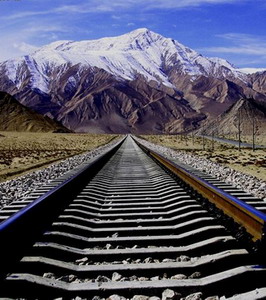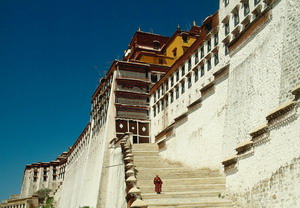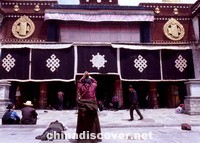Attractions along Qinghai-Tibet Railway

-
Name:Qinghai-Tibet Railway
-
Route :Xining to Lhasa
-
Length :1956 km (1215 mile)
-
Overview:Construction of the 815 km (506 mi) section between Xining and Golmud was completed by 1984. The 1142 km (709 mi) section between Golmud and Lhasa was completed bywas completed on 12 October 2005.
Xining
Xining is at an altitude of 2,275 meters above sea level and, as the starting point of the railway, is known as the "gateway to the Qinghai-Tibet Plateau." The city covers an area of 3,456 square kilometers, and one quarter of its total 1.1 million inhabitants is of the Hui and Tibetan ethnic minority.
Xining is an old town with a 2,000-year-long history, having been a main point on the old Silk Road. Prosperous, bustling Xining is the largest commodity supply center on the railway before the train arrives in Tibet. There are many shops in the city that sell traditional medicines and snack foods, and most of the shop owners are Hui people, who have a reputation for being hospitable and honest.
Tar Monastery
The Tar Monastery is the best-known monastery in Xining. As it is 25 kilometers to the southwest of the city, it is a sight to enjoy before boarding the train.
The monastery was built in 1560, and is dedicated to the Maitreya Buddha. It is the birthplace of Zongkapa, founder of the Gelug (Yellow) Sect of Tibetan Buddhism, and is regarded as a main center of Tibetan Buddhism in the northwest. As one of the six major Gelug Sect monasteries -- the other five being the Sera, Drepung, Tashilhungpo, Ganden and Labrang monasteries -- it is a grand complex that at its peak consisted of more than 800 halls and covered an area of 450,000 square meters.
The monastery is still eminent in Southeast Asia. Its main works of architecture include the eight pagodas that stand before the temple, the Grand Gold Tile Hall, the Grand Sutra Hall, the Lesser Gold Tile Hall, the Sutra Printing Hall and the Maitreya Buddha Hall.
The monastery houses many other cultural treasures, among which butter sculptures, frescoes and embossed embroidery are the three most precious. In the first, fourth, sixth and ninth lunar month of the Tibetan calendar, the monastery holds grand and elaborate celebrations. The birth of the Maitreya Buddha is celebrated by displaying a 100-m-long thangka on the mountainside and the performance of various Buddhist rituals.
Qinghai Lake
Qinghai Lake is the first major scenic sight along the Qinghai-Tibet Railway. The train from Xining to Lhasa passes the lake at night, while the return train passes it at about 7 am.
The lake name means "Blue Sea" in Tibetan and Mongolian, and it is the largest inland saltwater lake in China. It encompasses five islands in different shapes, of which Bird Island is the most captivating. Situated on the western shores of Qinghai Lake, its receding waters have rendered the island a peninsula. In spring and summer the lake attracts hundreds of thousands of migrating birds that nest on the island, and to which it acts as a bird sanctuary. Bird species that nest there include geese, gulls, sandpipers and cormorants.
Golmud
The Beijing-Lhasa express passes Golmud, the second largest city in Qinghai Province, which is at an altitude of 2,800 meters above sea level. In the Mongolian language, Golmud means a place where rivers gather.
Every day, large numbers of automobiles cruise along the Qinghai-Tibet Highway from Golmud, which locals refer to as the "automobile city."
Qarhan Salt Lake
To the west of Golmud, it is the world famous Qarhan Salt Lake that covers an area of 5,800 square kilometers. Because the lake is surrounded by hot, dry Gobi desert, its rate of rainfall is far lower than that of its evaporation. Consequently the lake surface is a 3 to 4 meter crust of concentrated salt, strong enough for cars to traverse and on which the Qinghai-Tibet Railway is constructed.
Kunlun Mountain
Soon after passing through Golmud the train heads into the snow-capped Kunlun Mountain. The Kunlun summit is the Yuzhu Peak, which is at an altitude of 6,178 meters above sea level, and facing it on the other side of the railway is the 5,933 meter-tall Yuxu Peak.
The Kunlun mountain range is considered sacred by Chinese Taoists. There is a legend that Xiwangmu, the Queen Mother of the Western Heavens and a deity within ancient Chinese Taoist mythology, holds her Peach of Immortality Banquet on the eighth day of the eighth lunar month every year and invites all immortals to her table.
The train climbs over the mountain range via the 1,686-m-long Kunlun Mountain tunnel -- the world's longest frozen earth tunnel -- at the Kunlun Mountain Pass at an altitude of more than 4,000 meters above sea level.
Hoh Xil Nature Reserve
The train then arrives at the Hoh Xil Nature Reserve, which covers an area of 250,000 square kilometers. It is the world's third largest uninhabited primal nature reserve and the largest in China.
As the average altitude there is 5,000 meters above sea level, the air is very thin. There are 16 mammal and 30 bird species living in the nature reserve, including some that are indigenous to the area, according to a survey made in 1990. In recent years, however, Hoh Xil has been plagued by poaching and environmental damage that is a cause of grave concern to naturalists and environmentalists.
Qumar
Qumar Station in Qinghai is designed in the shape of a Tibetan antelope, and an antelope sculpture also stands at its center. This is in recognition of Qumar Station's being a major stop on the migratory path of Tibetan antelopes.
Herds of wild donkeys, goas (a gazelle indigenous to the Tibetan Plateau easily mistaken for an antelope) canter and gallop around the area.
Tuotuo River
The next scenic spot of note along the railway is the Tuotuo River. It appears as a cluster of small steams, but is actually the source of the Yangtze -- one of the two major rivers in China that runs through 10 provinces, autonomous regions and municipalities.
Horse Racing Festival in Changtang Highlands
After going over the Tanggula Mountain Pass, the train enters the Changtang Highlands in northern Tibet. In August, the climate there is mild, and wild flowers in a profusion of colors bloom on the Changtang's lush grasslands.
An annual festival, whose main event is horse racing, is held on the broad grassland southeast of the town of Nagqu on the northern Tibet highlands.
This annual horse race tradition began in the 8th century, according to local inhabitants. At the time preparations for the race are being made, participant and spectator herdsmen from surrounding areas converge in Nagqu and erect their tents, creating a "tent city." When the races begin, everyone, riders included, dresses up in their most beautiful ethnic costumes and ornaments.
Tibetan women are particularly fastidious about their costume, as it is said that their wealth can be judged from their dress and jewelry.
The festival usually lasts seven days, and its many competitive events include long- and short-distance horse races, archery, high jump, long jump and weight lifting. This pastureland sports festival is also site of a trade fair for various agricultural and pastoral products.
Lake Namco
Namco, Tibetan for "heavenly" lake, is the largest lake in Tibet and the second largest saltwater lake in China, next to Qinghai Lake. At an altitude of 4,718 meters above sea level and covering an area of 1,920 square kilometers, Namco Lake is the highest in the world.
Tibetans believe that Buddhas, Bodhisattvas and Vajras assemble and hold religious ceremonies at Namco every year of the goat on the Tibetan calendar.
Circumambulation around the lake at a specific time is believed to equal one hundred thousand times that in normal years. Hence, on the 15th day of the fourth month of the Tibetan calendar, Buddhists flock to the lakeside on a pilgrimage to pay homage and pray.
Co Nag Lake
You can see Co Nag Lake from the train, the world's highest fresh water lake that has an area of more than 400 square kilometers.
Lhasa
The train's final destination is Lhasa, capital of Tibet Autonomous Region, a city at an altitude of 3,650 meters above sea level and a history of 1,300 years. Lhasa is the political, economic, cultural and religious center of Tibet.



